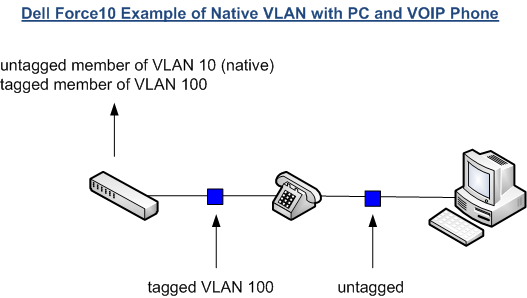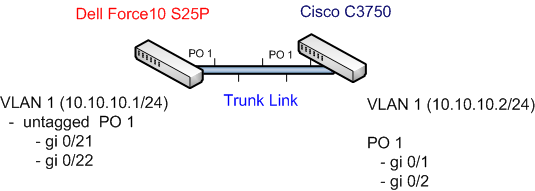 In this lab I use a Dell Force10 S25P switch [FTOS 8.4.2.6] and a Cisco C3750 switch [IOS 12.2(25)SEE3] to demonstrate 802.1Q trunking.
In this lab I use a Dell Force10 S25P switch [FTOS 8.4.2.6] and a Cisco C3750 switch [IOS 12.2(25)SEE3] to demonstrate 802.1Q trunking.
VLANs are local to each switch’s database, and VLAN information is not passed between switches. If it is desired for nodes on different VLANs on a switch to communicate to other nodes on the same VLANs on other switches via a single or limited amount of links, trunking will need to be configured. Trunk links are used to carry frames that belong to multiple VLANs between nodes over the same link.
A node can determine which VLAN the traffic belongs to by its VLAN identifier. The VLAN identifier is a tag that is encapsulated with the data. Cisco uses two types of encapsulation technologies – ISL (Inter-Switch Link) and IEEE 802.1Q. If you are using switches from vendors other than Cisco, you will need to use 802.1Q encapsulation for trunking; this is an open standard and even Cisco has moved more towards 802.1Q encapsulation.
The way that trunking is configured and the default behavior is totally different on Cisco and Dell Force10 switches; I have seen this cause a lot of confusion for customers using both switches in a heterogeneous environment. With Cisco, when you create a trunk, all VLANs are automatically tagged and transmitted down the trunk link. However, you can remove a VLAN from a trunk with the “switchport trunk allowed vlan remove [VLAN ID]” command. Conversely, on Dell Force 10 switches, a trunk link only sends VLAN traffic that has been explicitly tagged to be sent down the respective interface (ex: tagged gigabitethernet 0/1).
A second point of confusion is the native VLAN. The term “native VLAN” is really only valid when trunking is involved. The native VLAN is basically the VLAN traffic that will be sent down the trunk link automatically as untagged. In Cisco’s case, the native VLAN by default is VLAN 1 so all VLAN 1 traffic will be sent down the trunk link as untagged. Again, you can also change the native VLAN via the “switchport trunk native vlan [VLAN ID]” command.
On Cisco switches the default VLAN is VLAN 1 which also happens to be the default native VLAN. On Force10 switches, the default VLAN is VLAN 1 but the native VLAN is configured via a mechanism called a “hybrid port”. On a hybrid port, the native VLAN is the VLAN of which the port is an untagged member.
So let’s take VOIP (Voice over Internet Protocol) as an example. On a Cisco switch the VOIP phone may be added to say VLAN 100, and the native VLAN of the trunk could be set to VLAN 10. Then the Cisco switch would connect to the VOIP phone which would then connect to the PC as follows: Cisco Switch <----> VOIP phone <----> PC.
In the same scenario, the Force10 switch would be setup as below with the port on the switch connecting to the VOIP phone configured as a hybrid port.
Now that we understand the basics, let’s look at the below lab setup displaying the Dell Force10 S25P switch connected to the Cisco C3750 switch via Port Channel 1.
I have changed the default VLAN on the Force10 S25P via the following config mode commands:
– default-vlan disable
– default vlan-id 5
Next, on the Force10 S25P, I configure Port Channel 1 as a hybrid port in interface configuration mode and add the respective interfaces via the below commands:
– portmode hybrid
– channel-member GigabitEthernet 0/21-22
– sw
– no shut
– exit
– interface gigabitethernet 0/21
– no shut
– interface gigabitethernet 0/21
– no shut
Finally, on the Force10 S25P, I untag VLAN 1 on PO 1 and tag it on VLAN 2 and give VLAN 1 an IP address of “10.10.10.1/24”.
(in configuration mode)
– int vlan 1
– untagged Port-channel 1
– ip address 10.10.10.1/24
– no shut
– int vlan 2
– tagged Port-channel 1
– no shut
– end
– write
The following shows the output of the “show vlan” command on the Force10 S25P switch:
Now I need to configure the Cisco side. Here I also use the same Port Channel, PO 1, however, in this case I use interfaces gigabitEthernet 1/0/1 and gigabitEthernet 1/0/2. First, I create the static Port Channel.
(in configuration mode)
– interface gigabitEthernet 1/0/1
– channel-group 1 mode on
– no shut
– exit
– interface gigabitEthernet 1/0/2
– channel-group 1 mode on
– no shut
– exit
Second, on the Cisco C3750, I create the trunk:
– interface port-channel 1
– switchport trunk encapsulation dot1q
– switchport mode trunk
– no shut
Finally, on the Cisco C3750, I put an IP address on VLAN 1. Interestingly, on Force10 switches, you cannot configure an IP address on the default VLAN which also happens to be VLAN 1. In our case, we changed the default VLAN so we were able to do so. Also, note that VLAN 1 is the native VLAN so, if I ping the Force10 S25P switch, the packets should get sent across the trunk link (PO 1) as untagged packets and received on the Force10 switch as untagged packets.
– ip address 10.10.10.2 255.255.255.0
– no shut
The following shows the output of the “show vlan id 1” command on the Cisco C3750 switch:
From the below, you can see I have no problem pinging 10.10.10.2/24 on the Cisco switch from the Force10 switch.








 Twitter
Twitter LinkedIn
LinkedIn Youtube
Youtube RSS
RSS
Pingback: Humair’s Blogs » Blog Archive » Trunking and DHCP Across Dell Force10 Switches